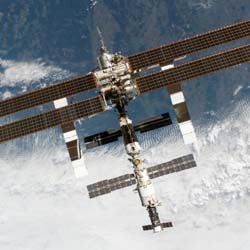
Picture from NASAl |
|
International Space Station ISS
|
|
Multi-Purpose international station for the space investigation.
Although the United States, through NASA, leads the ISS project, 15 other countries are involved in building and operating various parts of the station: Russia, Canada, Japan, Brazil, and 11 member nations of ESA (Belgium, Denmark, France, Germany, Italy, The Netherlands, Norway, Spain, Sweden, Switzerland, and the United Kingdom).
|
| Contributions include:
United States
- truss structures that provide the ISS framework
- four pairs of large solar arrays
- three nodes with ports for spacecraft and for passage to other ISS elements
- airlock that accommodates American and Russian spacesuits
- the American laboratory
- habitation and centrifuge accommodation modules
- power, communications and data services
- thermal control, environmental control and life support health
Russia
- two research modules
- service module with its own life support and habitation systems
- science power platform that supplies about 20 kilowatts of electrical power
- logistics transport using Progress vehicles and Soyuz spacecraft crew rotation
ESA
- Columbus Orbital Facility (pressurized laboratory and external payload accommodations)
- logistics transport vehicles to be launched by the Ariane V
Canada
- Mobile Servicing System (17-m-long robotic arm and with a smaller manipulator attachment
- a Mobile Remote Servicer Base to allow the robotic arm to travel along the truss
Japan
- on-orbit Kibo facility (pressurized laboratory, Logistics Module, and attached facility exposed to the vacuum of space serviced by a robotic arm
- logistics resupply using the H-2 launch vehicle
Brazil
- a pallet to house external payloads, unpressurized logistics carriers, and an Earth observation facility
|
| ISS components (in order of assembly):
Zarya (“Dawn”) control module
A 21-ton, 12.5-m-long, 4.1-m-wide module, equipped with solar arrays and six nickel-cadmium batteries capable of generating an average of 3 kW of power, that provided early propulsion, power, fuel storage, and communication, and served as the rendezvous and docking port for Zvezda. Zarya’s construction was funded by NASA and undertaken in Moscow by Boeing and the Khrunichev State Research and Production Space Center. Following its launch, it was put through a series of tests before being commanded to fire its two large engines to climb to a circular orbit 386 km high. The module’s engines and 36 steering jets have a six-ton reservoir of propellant to enable altitude and orientation changes. Its side docking ports are used by Russia’s Soyuz piloted spacecraft and Progress remotely-controlled supply vehicles. As assembly progressed, Zarya’s roles were assumed by other Station elements and it is now used primarily as a passageway, docking port and fuel storage site.
|
| Unity connecting module
The first American pressurized module of the ISS. Built at Marshall Space Flight Center, Unity provides six attachment ports, one on each of its sides, to which all future American modules will join. With two mating adaptors attached, it has a mass of 11,500 kg, a length of 10 m, and a diameter of 4.6 m.
|
| Zvezda service module
The first fully Russian contribution to the ISS and the early cornerstone for human habitation of the station. The 19-ton, 13.1-m-long Zvezda, provided the first living quarters aboard the station, together with electrical power distribution, data processing, flight control, and propulsion systems. It also has a communications system enabling remote command from ground controllers. Although many of its systems will eventually be supplemented or superceded by American components, Zvezda will remain the structural and functional center of the Russian segment of the ISS.
|
| Truss structure
An American-supplied framework that serves as the backbone of the ISS and the mounting platform for most of the station’s solar arrays. The truss also supports a mobile transporter that can be positioned for robotic assembly and maintenance operations and is the site of the Canadian Mobile Servicing System, a 16.8-m-long robot arm with 125-ton payload capability and mobile transporter which can be positioned along the truss for robotic assembly and maintenance operations.
|
Inside the Destiny lab
Destiny laboratory module
America’s main workstation for carrying out experiments aboard the ISS. The 16.7-m-long, 4.3-m-wide, 14.5-ton Destiny will support research in life sciences, microgravity, Earth resources, and space science. It consists of three cylindrical sections and two end-cones. Each end-cone contains a hatch through which crewmembers will enter and exit the lab. There are 24 racks inside the module, 13 dedicated to various experiments, including the Gravitational Biology Facility, and 11 used to supply power, cool water, and provide environmental control.
|
| Multi-Purpose Logistics Module
Effectively the ISS’s moving van. Built by the Italian Space Agency it allows the Space Shuttle to ferry experiments, supplies, and cargo back and forth during missions to the station.
|
| Some ISS statistics |
|
| First module launched (Zarya) |
November 20 of 1998 |
| Mass |
470 tons |
| Size |
109 x 88 m |
| Pressurized volume |
1,300 cubic m |
| Solar array area |
2,500 square m |
| Length of electrical wire |
13 km |
| Number of computers |
52 |
|
Note about 3D model.
The virtual model presented here, gives us an idea of how the ISS will be look once finished, since it includes all the original projected modules. The station was planned to be finished at 2006 end, but until now nobody knows when really it will be. |
Information from: David Darling's encyclopedia |